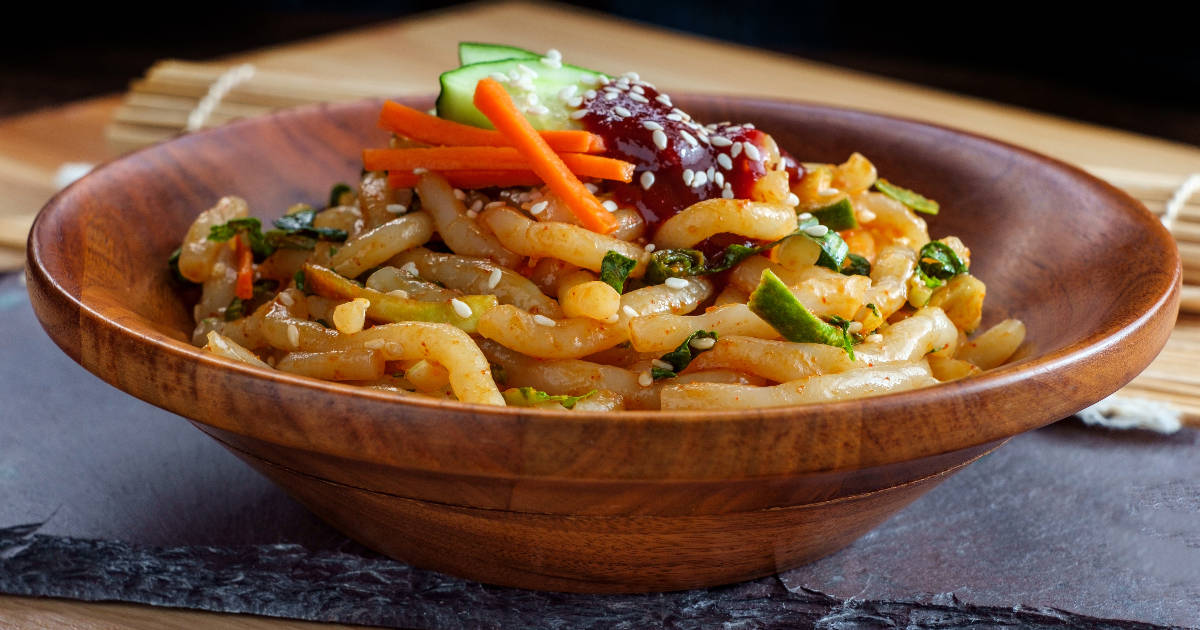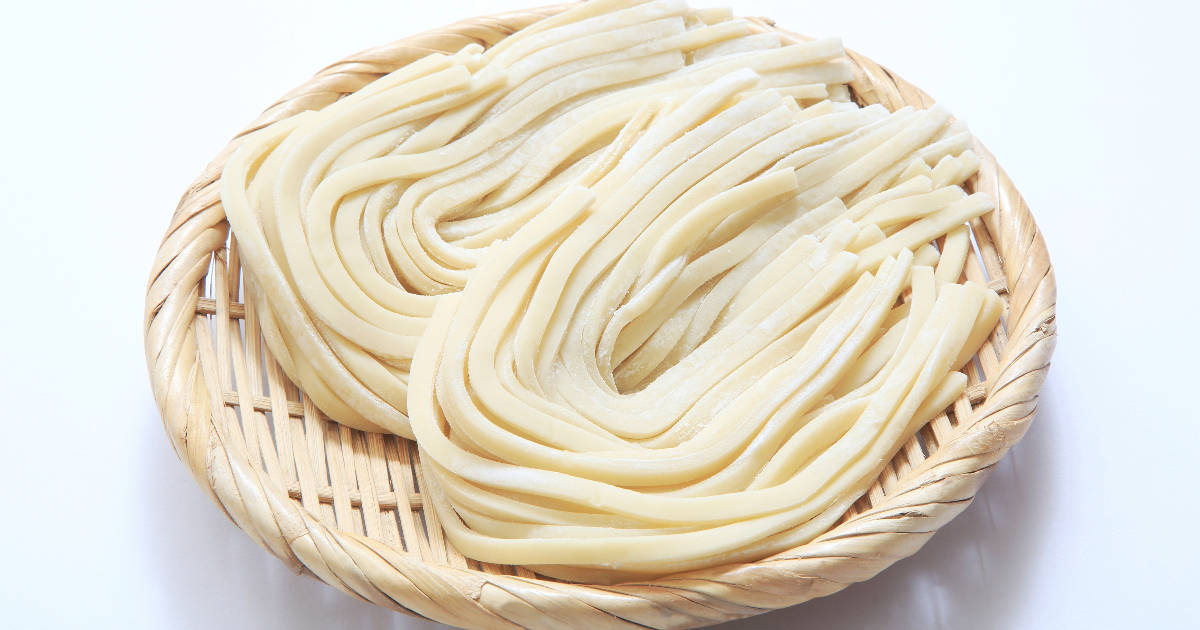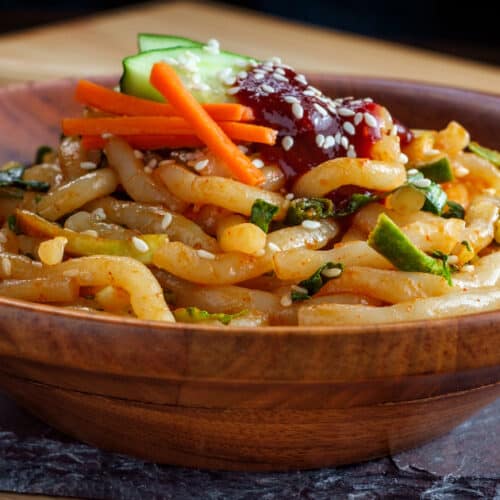Gochujang, also known as Korean chili paste, is a beloved ingredient in Korean cooking. This thick, sticky, and sweetly spicy condiment adds a unique depth of flavor and subtle heat to many Korean dishes.

Using gochujang to make a homemade udon noodle stir-fry creates a quick, easy, and delicious weeknight meal. The complex and addictive taste of gochujang pairs perfectly with chewy udon noodles and fresh vegetables. Read on to learn how to make a flavorful gochujang udon recipe at home.
Traditional Ingredients
Gochujang is traditionally made from fermented soybeans, glutinous rice powder, salt, and chili powder. This blend of ingredients gives the paste its characteristic sweet, salty, and spicy flavors. When added to dishes like udon noodles, gochujang brings a rich umami taste and subtle heat. Store-bought gochujang can be found in Asian grocery stores and many large supermarkets. When making gochujang udon, be sure to use authentic Korean gochujang rather than substituting another chili paste.
In addition to gochujang, this udon noodle recipe calls for other classic Korean and Japanese ingredients like toasted sesame oil and mirin. Toasted sesame oil has a strong, nutty flavor that enhances the taste of the stir-fry. Mirin is a Japanese rice wine that lends sweetness and acidity. Both ingredients can be found in many grocery stores these days, but Asian specialty markets will have the best selection.
Picking the Right Noodles

Udon noodles are the perfect choice for pairing with a gochujang udon. These thick, wheat flour noodles have a satisfying chewy-soft texture that soaks up stir-fry sauces beautifully. Both fresh and dried udon noodles work well in this recipe. If using dried udon noodles, remember to reduce the cooking time to avoid mushy noodles.
Other noodles like ramen, lo mein, or spaghetti can be substituted for the udon if needed. However, udon's thickness stands up best to the sticky gochujang sauce. For a gluten-free option, rice noodles or bean thread noodles are an easy swap.
Stir-Frying the Vegetables
One of the great things about gochujang udon is that you can customize the vegetables according to what you have on hand or enjoy eating. Classic stir-fry veggies like bell peppers, carrots, broccoli, and cabbage work beautifully. For variation, try mushrooms like shiitake or oyster which add hearty, earthy flavors. Greens like spinach or bok choy wilt nicely at the end to complete the noodle dish.
No matter what veggies you choose, the key is to prep them before starting to cook so that the stir-frying goes quickly. Also, cut the vegetables into uniform pieces so they cook at the same rate. To retain their crispy-tender texture, avoid overcooking the vegetables in the wok or skillet.
Bringing It All Together
Making gochujang udon is a fast and easy weeknight dinner when you have the ingredients prepped beforehand. Here's a quick run-through for assembling the dish:
- Cook the udon noodles according to package directions. Rinse under cold water to stop the cooking process. Toss with oil to prevent sticking.
- Whisk together the gochujang sauce ingredients.
- Heat oil in a wok or skillet over high heat. Cook aromatics like garlic, ginger, and scallions briefly. Add the vegetables and stir-fry until almost done.
- Add the gochujang sauce mixture to coat the vegetables.
- Toss in the cooked udon noodles and mix well so they soak up the sauce.
- Garnish with toppings like sliced scallions, toasted sesame seeds, or crushed red pepper flakes.
Customizing Your Udon
Once you master the basic gochujang udon recipe, there are endless ways to adapt it to your personal tastes or what you have in your kitchen.
- Adjust the spice level by using more or less gochujang and gochugaru (Korean chili flakes).
- Swap in different vegetables like bell peppers, snap peas, shredded cabbage, broccoli, etc.
- Add protein such as cooked chicken, shrimp, beef, or tofu.
- Mix in other sauces like oyster sauce, hoisin, or miso paste.
- Top with a fried egg, kimchi, seaweed, or fried shallots.
- Make it gluten-free by using tamari, gluten-free gochujang, and noodles like rice vermicelli.
The possibilities are endless, so feel free to get creative! The important thing is starting with that flavorful gochujang sauce coating chewy udon noodles.
Serving Suggestions
While gochujang udon is satisfying on its own, a few simple sides round out the meal beautifully:
- An Asian-style salad with cabbage, carrots, cilantro, and a ginger dressing
- A small bowl of miso soup
- Steamed rice or crispy fried rice
- Quick kimchi or cucumber salad
- Dumplings or egg rolls
A pot of jasmine green tea is the perfect beverage to accompany your spicy-sweet noodle dish. With a simple salad or soup alongside, gochujang udon makes an easy, nutritious, and crave-worthy weeknight dinner.
Tips for Leftovers
Like many noodle dishes, gochujang udon is best fresh, but leftovers will still taste good a day or two later. To store leftovers:
- Place udon noodle servings in airtight containers in the fridge.
- The noodles may continue to absorb the sauce, so add splashes of water when reheating to loosen them.
- Microwave individual portions with added water to reheat.
- Or reheat gently in a skillet with a bit of oil and water. Avoid overcooking.
FAQ
What kind of noodles work best for gochujang udon?
Thick, chewy udon noodles are the perfect choice as they cling well to the sticky chili sauce. However, you can also use ramen, lo mein, rice noodles, or spaghetti. Adjust cooking times as needed for the noodle variety.
Can I make gochujang udon gluten-free?
Yes! Use tamari instead of soy sauce and swap the udon for rice noodles or bean thread noodles. Be sure to use a gluten-free gochujang product.
What protein can I add to my gochujang udon?
Popular mix-ins are cooked chicken, shrimp, beef strips, or tofu. Fry the protein first before adding your vegetables and sauce. For convenience, rotisserie chicken works great!
What are some substitutions for gochujang?
There's really no adequate substitute for gochujang that replicates its complex flavor. For less heat, you can use less gochujang and chili flakes. If you don't have it, some umami-rich combinations could work like miso paste, soy sauce, sesame oil, and chili garlic sauce.
Can I prepare gochujang udon noodles in advance?
Yes! Cook the noodles then toss them in oil to prevent sticking. Whisk the sauce ingredients together ahead of time as well. Store the components separately and stir-fry them together when ready to eat. The vegetables can be prepped a day in advance too.
Conclusion
Whipping up a batch of gochujang udon is one of the tastiest ways to add authentic Korean flavor to your weeknight dinner rotation. The depth of flavor from the sweet and spicy gochujang pairs perfectly with chewy udon noodles, crisp-tender vegetables, and sizzle-worthy stir-frying. This customizable noodle dish comes together in under 30 minutes and satisfies cravings for a fast, fresh meal any night of the week. Keep a few pantry essentials like gochujang, udon noodles, and sesame oil on hand so you can throw together this tasty noodle stir-fry anytime.

Gochujang Udon
Ingredients
- 8 oz udon noodles
- 2 Tbsp sesame oil, divided
- 1 lb boneless skinless chicken thighs, diced
- 1 cup sliced mushrooms
- 1 red bell pepper, sliced
- 3 cloves garlic, minced
- 1 Tbsp grated fresh ginger
- 2 Tbsp gochujang (Korean chili paste)
- 2 Tbsp soy sauce
- 1 Tbsp brown sugar
- 1 tsp toasted sesame oil
- 1/4 cup chopped scallions, for garnish
Instructions
- Cook udon noodles according to package directions. Drain and rinse under cold water. Toss with 1 Tbsp sesame oil to prevent sticking.
- Heat remaining 1 Tbsp sesame oil in a large skillet or wok over medium-high heat. Add chicken and stir-fry until lightly browned, about 3-5 minutes.
- Add mushrooms, bell pepper, garlic, and ginger. Stir-fry for 2 minutes.
- In a small bowl, combine gochujang, soy sauce, brown sugar, and toasted sesame oil. Pour mixture into skillet and cook for 1 minute.
- Add udon noodles and toss everything to coat well, about 2 minutes.
- Transfer to serving plates and garnish with scallions. Enjoy immediately!

